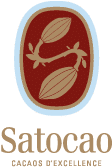The Satocao plantations
as a model of excellence
Satocao received from the São Tomé government a concession of about 1,360 ha for a duration of 25 years which is renewable.
This concession had been abandoned for decades and it’s earmarked to develop high value agricultural cultures.
Following this agreement, Satocao has refurbished this concession and planted around 300 ha of selected hybrid cocoa trees.
At the heart of the company’s culture is its emphasis on maintaining rigorous quality control in order to achieve a product of excellent quality.
Thanks to a very strict traceability process the cocoa beans will come with a guarantee of origin and its crop will be certified.
This will help the company with its medium term goal of establishing a designation of origin and mark of high quality for São Tomé e Príncipe’s cocoa.
Cocoa tree
A tropical species that was first domesticated approximately 3,000 years ago by the Mayans, most likely for the production of a fermented beverage. This is an evergreen cauliflory tree than can measure ten to fifteen meters. Cualiflory mean its flowers are produced in clusters directly on the trunk and older branches. The trees are generally cut at 2 or 3 meters. It grows in the shade of the canopy formed by taller vegetation. its flowers blossom all year round directly on the bark of the tree.
Cocoa pods
The fruits of the cocoa tree or cocoa pods can weigh as much as 400 grams and are between 15 and 20 cm long. They can grow both out of the branches of the tree and directly on the tree’s trunk. Gestation of the fruits takes between 5 and 7 months. On average a tree can produce around 25 pods per year yielding a total of almost 900 grams of cocoa. The pods contain anywhere from 25 to 65 seeds. These are the cocoa beans. Each wet cocoa seed is enveloped in a sweet, white liquid mucous which allows for the fermentation necessary for the production of marketable cocoa.
The revival of nurseries
The plantations are distributed in a number of fertile regions of São Tomé e Príncipe creating a broad area of operations for the company and allowing for collaboration with a number of the local villages. Several beautiful nurseries have been established on the island to support the expansion of Satocao’s plantations. The agronomists and plantation managers work hand in hand combining their expertise with the know-how of the local workers. All the plant material originates from nurseries on the island in order to respect and develop the integrity of São Tomé’s cocoa “terroir”.
A rare and fragile genetic heritage
As part of the process of selecting cocoa beans, chocolatiers research their specific flavour qualities. In São Tomé e Príncipe Amelonado, which originates from the deep Amazon, has a particularly soft and fruity taste. This strand of cocoa was first introduced to Príncipe in 1822 and to São Tomé in 1830. Sheltered by the isolation of São Tomé the Amelonado species on the island was able to escape a number of epidemics. Satocao is proud of the unique genetic qualities and characteristics of its beans.


